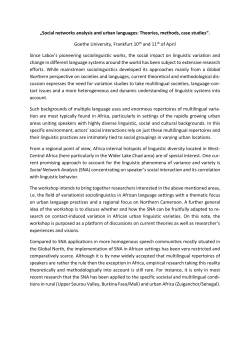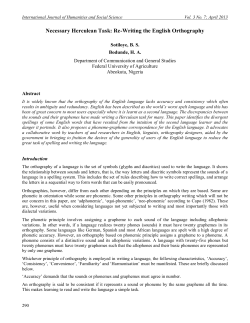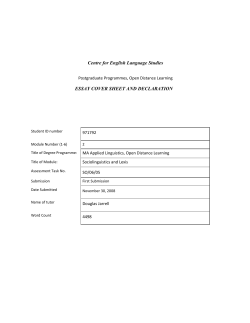
WRITING SYSTEMS Hans Christian Luschützky Department of Linguistics, University of Vienna
WRITING SYSTEMS Hans Christian Luschützky Department of Linguistics, University of Vienna hans.christian.luschuetzky@univie.ac.at http://homepage.univie.ac.at/hans.christian.luschuetzky/ Training Course on Toponymy Run-up to the 23rd Conference of the United Nations Group of Experts on Geographical Names Vienna, March 2006 The Importance of Writing ➡ Writing is a cultural technique – unlike speaking, which is a mixture of instinct-driven interactional behaviour and psychophysical reflex ➡ Writing (including calculating) is the most momentous and most important cultural technique of mankind ➡ Writing has for long been the only possible way of transmitting information deliberately and selectively over geographical and temporal distances What is Writing? The term writing (German: Schrift, French: écriture, Spanish: escritura, Italian: scrittura, Russian: писмо, Albanian: shkrim, Turkish: yazı, Farsi: ﺧﻂetc.) refers to any system of communication based on conventional, permanent, visible signs Communication Writing serves the transmission of information and is thereby distinct from ornaments ❁❂❃ ✾✽✼✻ System Writing is articulate, made up of characters (segmentable functional items), and thereby distinct from drawing and painting System Writing is articulate, made up of characters (segmentable functional items) and thereby distinct from drawing and painting HARE : BARE CARE : DARE FARE : MARE PARE : RARE TARE : WARE System Writing is articulate, made up of characters (segmentable functional elements) and thereby distinct from drawing and painting (?) Conventional In a writing system, the correlation of form and meaning (or function) of the characters is intersubjective – writing is thereby distinct from scribble Roman handwriting on a wax tablet of 139 AD found in 1855 at Verespatak (Transsylvania) Maximus Batonis puellam nomine / Passiam sive ea quo alio nomine est an / circiter plus minus empta sportellaria / norum sex emit manicipioque accepit / de Dasio Verzonis Pirusta ex Kaviereti ✱ ducentis quinque. (Maximus Batonis has bought a female slave) Permanent The characters of a writing system and their arrangement are constant over greater ranges of time – writing is thereby distinct from gestural and mimic communication (“sign language”) Visible The characters of a writing system and their arrangement are optically perceivable – writing is thereby distinct from speech Sign Writing is an artifact, its form and content being situated in an interpretational context – writing is thereby distinct from phenomena of the physical world Delimitation: Character versus Symbol Symbols, emblems, logos, badges, insignia etc. can partly fulfill the function of writing ... Delimitation: Character versus Symbol ... but normally they don’t – therefore they can be considered as substitutes or complements of writing at best. On the other hand, characters can assume symbolic value, e.g., the victory sign made with two fingers: ✌ • characters constitute a closed class of signs • symbols constitute an open class of signs Definition of Symbol ➡ Any perceivable sign or image (object, event, action ...) that can be interpreted as a substitute for something non-perceivable (a unit of sense, often embedded in a complex of sense-relations: wedding ring, crucifix, crescent…) ➡ Inˇa more restricted sense, any written sign or picture with conventional or evident meaning. Thus symbols play an important role in religion, art, literature, but also in science: physical, chemical, mathematical symbols, symbols in data processing, technology and engineering (e.g., diagrams) ➡ In everyday life, symbols appear as pictograms, traffic signs, product labels and the like Signs and (some of) their Functions ➡ Expressive function: providing information about the state of the bearer or sender of the sign (e.g. national flag, tattoo, piercing, decoration, medal) ➡ Triggering function: causing or preventing actions (e.g. traffic signs, advertisements) ➡ Identificational function: marking possession or authorship (e.g. pottery marks, cattle marks, library signatures) ➡ Authentificational function: confirming the genuineness or validity of something (e.g. stamps, embossments, watermarks in bank notes) ➡ Mnemonic function: keeping record of events, transactions etc. (e.g. bills, receipts, chronicles) ➡ Descriptive function: providing information about a fact or state of affairs (primary function of writing) What kinds of linguistic units can be represented by means of the signs of a writing system (graphemes) ? Whole texts ? So-called pictorial writing of prehistoric epochs and picture stories of all cultural spheres and ages (up to modern comic strips) represent complex contents but no cohesive text in the linguistic meaning of the term. Pictorial writing suggests a potential text without formal guidelines. What kinds of linguistic units can be represented by means of the signs of a writing system (graphemes) ? Sentences ? Graphemes representing complete syntactic constructions without being made up of subordinate constituents (phraseograms) are conceivable in principle, but do not occur in reality – not even in shorthand (stenography, tachygraphy). Since the number of possible sentences in any language is unlimited, a fully phraseographic writing system could not be managed by human cognitive processing and memory. What kinds of linguistic units can be represented by means of the signs of a writing system (graphemes) ? Phrases ? With regard to the relation form ⇔ content, so-called abbreviations have a special status. A short string of signs may stand for a whole sentence or phrase, but still this is not an instance of phraseography, since every item of the string represents a word, usually as an acronym. Some examples: faq for frequently asked questions aka for also known as asap for as soon as possible What kinds of linguistic units can be represented by means of the signs of a writing system (graphemes) ? Meaning Single graphemes can convey complex meaning (statements, predicates, propositions and the like) but are not bound to specific formulations in terms of linguistic structure. A cross † accompanying a personal name can be read as „dead“, „deceased“, „passed away“, „no more alive“ and the like. Signs of writing that do not represent word forms or phrases but abstract concepts or relations (i.e. lexical meaning or propositional meaning) are called ideograms. What kinds of linguistic units can be represented by means of the signs of a writing system (graphemes) ? Meaning Mathematical signs and symbols of formal logic are usually ideographic: √, ∀, ∑, ∞, %, etc. The typology of ideograms is based on their motivation. Some examples: Acrophonic motivation, like ∑ – after the initial sound of the word sum(ma), written with the Greek letter Sigma Iconic motivation, like √ – iconicity is a matter of degree: one could think of a sign that more resembles a “root” than √, but at least there are many other signs that less resemble a “root”…. The most iconic type of ideograms are pictograms (signs bearing a strong resemblance to the concept they denote). Pictograms are used in many fields of everyday life, especially in multilingual environments (railway stations, airports, etc.), but also in cartography Arbitrary (no recognizable motivation), like : for “division” – on keyboards of calculators likewise arbitrary / and ÷ occur with the same meaning Ideograms can be polysemic, like + meaning “addition” in mathematics, “positive charge” in electrical engineering, “attested in” in philology (accompanying an author’s name), etc. Pictograms: a language-independent system of signs for orientation What kinds of linguistic units can be represented by means of the signs of a writing system (graphemes) ? Words Lexical items of a language can be represented by means of simplex (non-composite) graphemes (logograms). Logograms are phonographic, since they refer to the form of a word (its sound shape, a string of phonemes), not to its content. Since words are made up of recurrent elements of form (syllables, phonemes), a logographic writing system would be highly uneconomic: why use an enormous amount of different signs, if the amount of distinctive sounds is much smaller? On the other hand: why write highly frequent words sound by sound, if they can be written with a single sign? Thus for practical reasons in many writing systems ideograms and logograms are used in addition to phonograms, according to the economy of expression. Notice that in the Chinese writing system, which is often superficially characterised as “pictographic”, 90 percent of the signs are so-called composite characters, made up of an ideogram denoting the meaning and a phonogram indicating the pronunciation. Examples for the xingsheng sign type (ideogram-phonogram) PHONOGRAM [phonetic value] + IDEOGRAM semantic value = SIGN VALUE 馬 [mǎ] + 虫 insect = [mà] grasshopper The meaning of the phonogram ( horse ) and the pronunciation of the ideogram ([tʃóŋ]) are irrelevant 馬 [mǎ] + 口 mouth = [mà] to scold The meaning of the phonogram ( horse ) and the pronunciation of the ideogram ([kǒw]) are irrelevant 馬 [mǎ] + 石 stone = 碼 [mǎ] weights The meaning of the phonogram ( horse ) and the pronunciation of the ideogram ([ʃí]) are irrelevant Old Persian Cuneiform Script (525-330 BC) Phonograms (syllabograms), logograms and arithmograms What kinds of linguistic units can be represented by means of the signs of a writing system (graphemes) ? Words, Syllables, Phonemes Due to their function and semiotic value, ideograms are close to symbols, whereas logograms are close to abbreviations and pictograms are close to images. Creative interaction of ideographic, logographic and phonographic writing can be observed in modern scribal tendencies among users of computers and cellphones, taking advantage of, e.g., the homonymy of numerals and other lexical items: 4U “for you”, cul8er “see you later” and so on. The history of writing is not a linear evolutionary process from pictographic stages to the alphabet, but a multimodal adaptive process during which different semiotic techniques have established themselves in favouring functional niches. typology of writing systems Type Examples syllabic Mycenaean Linear B Japanese Kana logo-syllabic Sumerian cuneiform Chinese logo-consonantal Egyptian hieroglyphs consonantal phonemic Phoenician Hebrew Arabic Greek Latin Cyrillic History of the Alphabet (mainstream developments only) Mesopotamian Cuneiform Egyptian Hieroglyphs Proto-Sinaitic / Canaanite Phoenician Greek Aramaic Etruscan Cyrillic Latin Hebrew Arabic
© Copyright 2025





















